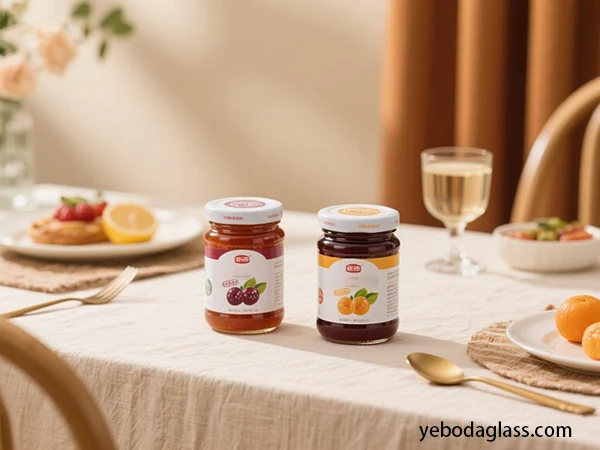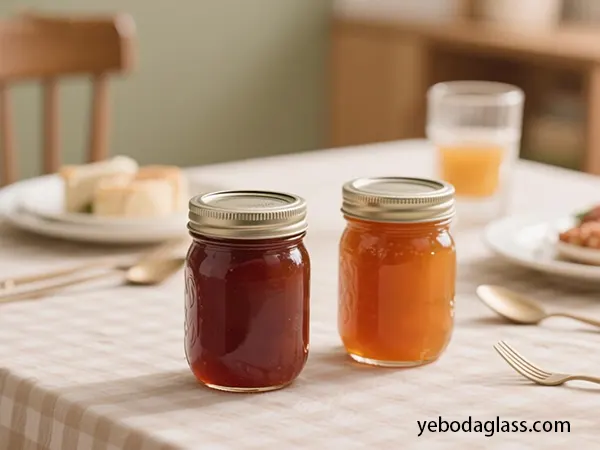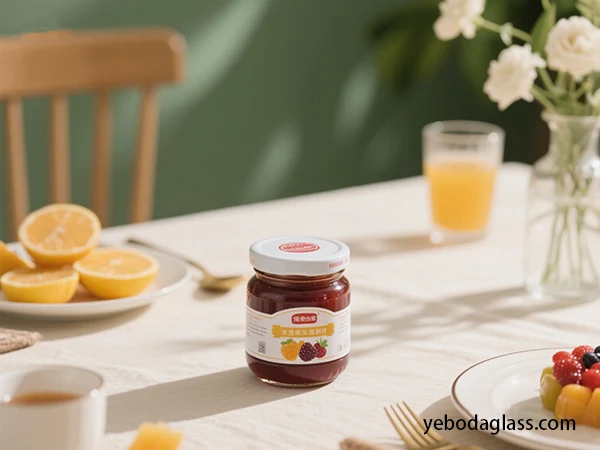Wstęp
Packaging plays an important role not only in product protection and brand presentation in highly competitive food market, especially for small jam jars, but also as an important cost driver. For companies operating wholesale small jam jars, adjusting packaging costs without compromising quality or market appeal is an important strategic imperative. This report provides a comprehensive framework to identify and apply the strategies of cost reduction in the packaging life cycle, including material selection and design to sourcing, logistics and lifestyle ideas. We focus on providing actionable insights that can maximize cost savings, improve operational efficiency, and promote long – term stability.

Small Jam Jars Packaging & Cost Overview
Detailed Component Analysis
A specific small jam jar packaging system contains many different components, each contribute to overall cost and functionality:
- Primary container (jar): This is the most important component. For “small jam jars”, it usually refers to versions ranging from 1.5 ounces (43 mL) to 8 ounces (227 mL). Major specifications include materials (mainly glass, sometimes pet plastic), size, neck finish (eg, 43 mm, 53 mm, 63 mm), weight, clarity and color.
- Closed (lid/cap): material (metal, plastic), type (twist-off, constant thread), liner (required for sealing), and decoration.
- available in wooden, ceramic, or specialized metal finishes, all elements need to ensure an airtight seal. Material (paper, film), adhesive, printing method and application.
- Secondary packaging: dividers/partitions, coaches/trays (corrugated cardboard), and protective filler.
- Tertiary packaging: palettes (wood, plastic), stretch rap (LLDPE film), and corner board.
Establishing the Cost Baselines
A comprehensive cost baseline only requires a granular breakdown of expenses beyond the purchase prices. It also includes:
- Direct material cost: unit cost for jars, lids, labels and secondary/tertiary packaging.
- Indirect packaging cost: freight-in, inventory holding costs, labor, waste and reunion,
equipment maintenance, quality control and disposal costs.
By carefully documenting these costs for a defined period, a clear “per packed unit” can be calculated, serving as a benchmark for future cost-spending initiatives.
Material and Design Optimization Strategies
Optimizing the materials and design of small jam jars offers some of the most direct and impactful avenues for cost reduction.
Jar Material and Weight Reduction
Glass remains the preferred material for jam jars due to its inertness and premium perception. However, its weight contributes significantly to freight costs.
- 4.1. Closed-Loop Recycling and Certifications This primary strategy involves producing słoiki szklane with thinner walls and bases while maintaining structural integrity. Even a few grams reduction per jar, scaled across millions of units, translates into substantial material and shipping cost savings for jam jars. This must be balanced with product protection and consumer perception.
- Alternative materials (Strategic Use): PET plastic can be viable for specific product lines, offering lighter weight and breakage resistance, ideal for e-commerce or environments where glass breakage is a concern.
Tak, tak. is known for manufacturing high-quality glass containers, including a wide range of small jam jars. Their advantages often include consistent quality, minimizing defects and enhancing brand image. Yeboda’s adherence to industry-standard neck finishes simplifies lid procurement, allowing for greater supplier choice and competitive pricing for closures of glass jars.
Neck Finish Standardization
Standardizing the neck finish across different glass bottles or product lines yields significant savings by reducing SKU complexity, enabling bulk purchasing, and improving operational efficiency on capping lines.
Closure Optimization
Lids contribute significantly to unit cost. Strategies include optimizing material choice, ensuring appropriate liner selection without over-specifying, and minimizing or simplifying lid decoration.
Labeling Efficiencies
Label is important for branding, but can be adapted by selection (paper vs. film), reducing size and complexity, by selecting the right printing technique (flexographic for small runs for small runs), and evaluating the integrated design in products.
Secondary Packaging Redisine
The coaches and dividers for wholesale small jam jars can be adapted through the right-shaped to reduce zero space, using the strength of the appropriate corrugated board, adapt the divider design to use less materials, and reduce printing for the necessary information.
Purchase and Supply Chain Capacity
Strategic procurement and streamlined supply chain management are necessary to reduce packaging costs for small jam jars.

Volice-Based Discount and Supplier Consolidation
- Annual volume aggregation: Mix the purchase requirements for jars, lids and labels to maximize the power of bargaining and safe wholesale discounts.
- Suppliers consolidation: Limit the number of suppliers to simplify logistics, cut administrative costs and make strong pricing and strong partnership for service.
- Long-term contract: Interaction on multi-year agreements to stabilize pricing and ensure frequent supply.
Strategic Sourcing and Interaction
- Competitive bid: periodically conduct competitive bid to ensure market-transport pricing.
- Total cost of ownership (TCO): Evaluate TCO, considering material costs, freight, lead time, quality and reliability, not only unit value.
- Terms of payment: Interaction on favorable payment conditions to improve cash flow.
Raw material sequencing: Commodity for glass and metal includes clan for price adjustment based on ups and rackets in the market.
Inventory Management and Lead Time Optimization
- Just-in-time (JIT) principles: Implement JIT inventory where possible to minimize holding costs.
- Safety stock optimization: Calculate optimal safety stock based on variability, avoiding arbitrary levels.
- Vendor-managed inventory (VMI): Explore VMI programs where suppliers manage inventory.
- Lead time reduction: Work with suppliers to reduce lead times, enabling lower inventory holdings.
- Op maat gemaakte olie-azijnflessen voor het Nieuw-Zeelandse merk: duurzaam, lekvrij en prachtig ontworpen om de versheid te behouden en de aantrekkingskracht van het schap te vergroten. Improve demand forecasting for finished products to optimize material orders.
Logistics and Shipping Cost Reduction
Logistics and shipping represent a significant portion of the total cost for wholesale jam jars.
Packaging Configuration for Cube Utilization
- Pallet optimization: Design secondary packaging (cartons) to maximize the number of small jam jars per carton and cartons per pallet, improving “cube utilization.”
- Minimizing void space: Ensure jars fit snugly within cartons and dividers to avoid shipping air.
- Stacking strength: Design cartons with sufficient strength to prevent crushing during transit.
Palletization Schemes and Protection
Stable Pallet Loads: Ensure secure, stable pallet loads using interlocking patterns, high-quality stretch wrap, and corner boards to prevent damage and enhance load integrity. Damage reduction is a direct cost-saving measure.
Choice of Shipping Methods and Carriers
- Freight class optimization: Understand and optimize the freight class of glass jar.
- LTL vs. FTL: Choose between minimal-to-trunkload (LTL) and full truck load (FTL), where possible, consolidating LTL shipments.
- Carrier interaction: interaction at rates with multiple carriers, taking advantage of shipping volume.
- Incoterms: Define incoterms to clearly understand the responsibility for the goods cost.
Process Automation and Waste Shortage
Customizing the internal packaging process significantly reduces labor costs, improves efficiency, and the material for glass jars reduces waste.
Packaging Procedures
- Lean theory: Apply lean manufacturing to eliminate waste on the packaging line.
- Line layout adaptation: Ensure an ergonomic and efficient layout.
- Standard operational procedures (SOPs): Develop clear SOPs for stability and reduction in error.
- Preventive maintenance: Apply maintenance to packaging machinery to reduce downtime.

Opportunities for Automation
Adequate returns can be found in incremental automation. Consider:
- Automatic filling, capping and labeling: the product reduces cheaper, ensures frequent sealing, and the application for jam jars improves accuracy.
- Automatic case packing and palatizing: reduces manual labor and improves efficiency and stability.
- Idea: Automation depends on the amount and capital of the feasibility production; Start with bottlenecks.
Minimizing Material Waste
- Quality control in inbounds: Inspection the ingredients coming for defects.
- Customized machine settings: Calibrate the machinery properly to reduce splitse and errors.
- Operator training: Properly trained operators reduce waste.
- Recruitment program: Apply strong recycling for packaging waste to reduce disposal costs.
Cost-saving Liver Initiative
Many environmentally friendly packaging initiatives can cause cost reduction by increasing brand reputation directly.
Recycled Materials and Circular Economy
- Post-conjumer recycled (PCR) glass: The jam jam with high PCR material can be sourced cost-effective and reduces the demand for virgin material.
- Recycled materials in other components: use recycled materials for coaches, labels and stretch films.
Lightweight for Environment and Economic Benefits
Lightweight glass jar reduces physical use and freight transport emissions, a “win-win” strategy that cuts cost and environmental impact offers a powerful marketing message.
Re -Purpose and Refillable Packaging (Speculative)
For local or special markets, deposit-return schemes or refill stations can be future costs and stability liver, which can eliminate new primary packaging costs despite logical challenges.
Biodegradable and Compostable Materials (Contrarian Idea)
The discovery of biodegradable or compost material for label or secondary packaging can be aligned with stability goals, potentially reduce settlement costs and offer an environmental story, although the performance must be carefully evaluated.
Emerging Packaging Technologies and Future Approaches
Living among new technologies is important to proof your packaging strategy for future small jam jars.
Advance Manufacturing Technology
- 3D printing: Create molds for fast custom jar design or prototype, reduce the time and cost of development.
- AI and machine learning: optimize glass furnace operations, predict equipment failures, and increase quality control for jam jars, which reduces production costs.
Smart Packaging Solution
Elements of smart packaging can provide benefits beyond traditional cost savings:
- QR code and NFC tags: to increase brand engagement and transparency, potentially justify high label costs.
- Time-papan indicators (TTI): Ensure the quality of the product and reduce the poor claims.
- Anti-counterfeiting features: Protect brand integrity for premium jam jars.
New Material
- Bio-based and recycled plastic: Virgin offers permanent and potential cost-effective options for pets.
- Advanced barrier coatings: Improves shelf life for plastic jars, opening opportunities for lightweight.
Data Analytics for Supply Chain Optimization
- Predictive analytics: Use AI to analyze data and predict a jam jar with more accuracy, adapt inventory and reduce waste.
- Blockchain for traceability: increasing transparency, ensuring moral sourcing, and reducing allied costs, streamlining recall processes.

Wniosek
Customizing packaging costs for bulk small jam jars is a versatile attempt, requiring material science, design, purchase, logistics, operational efficiency, and a composite approach in a forward -looking perspective on stability and emerging technologies. Businesses can get significant cost cuts by strategically applying lightweight and design optimization, streamlining purchases, automating packaging lines, and embracing permanent practices. The journey of cost adaptation is constant, demanding innovation for ongoing evaluation, adaptation and long -term success.




